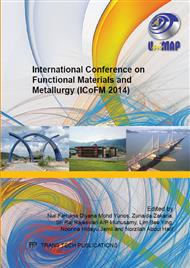p.39
p.45
p.50
p.57
p.63
p.71
p.76
p.81
p.87
Effect of Aluminium and Silicon to IMC Formation in Low Ag-SAC Solder
Abstract:
The effect of Al and Si addition on IMC formation at the solder and Cu substrate interface was investigated. The compositions of the solder alloy used are Sn-0.3 wt.% Ag-0.5 wt.% Cu (SAC0305), SAC0305-1 wt.% Al (SAC0305-1Al), SAC0305-2 wt.% Al (SAC0305-2Al) and SAC0305-2 wt.% Al-2 wt.% Si (SAC0305-2Al-2Si). Solder alloys were prepared by casting process. Melting temperature of each solder alloys was determined using DSC. Reflow process of the solder alloys were carried out at 260 oC on Cu substrate. Morphology of the intermetallic compound (IMC) formed at the solder joint was observed using Fe-SEM equipped with EDX. The addition of Al and Si reduced the thickness of IMC layer formed at the solder joint. The addition of 1.0 wt.% Al formed planar shape of IMC while the addition of 2.0 wt.% Al and 2.0 wt.% Al with 2.0 wt.% Si formed scallop shape of IMC. This is due to Cu-Al IMC and Ag-Al IMC scattered near the interface that act as diffusion barriers to Sn diffusion. This suggests that the addition of right amount of Al and Si could form thinner IMC layer that could lead to increase of reliability of solder interconnect.
Info:
Periodical:
Pages:
63-67
Citation:
Online since:
June 2015
Keywords:
Price:
Сopyright:
© 2015 Trans Tech Publications Ltd. All Rights Reserved
Share:
Citation:


